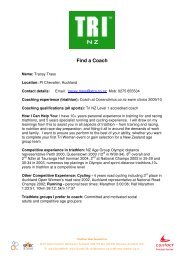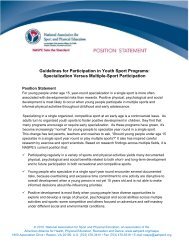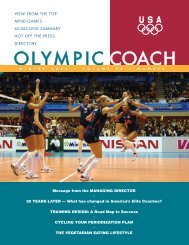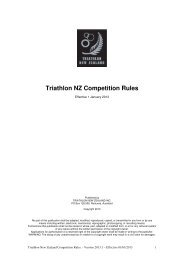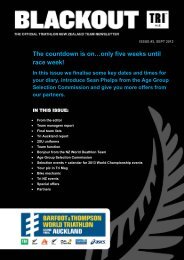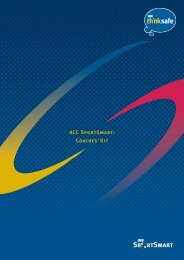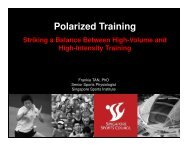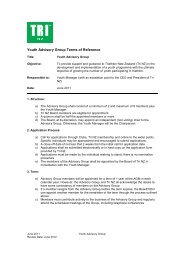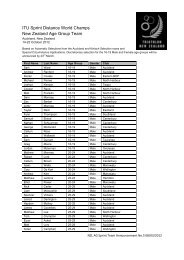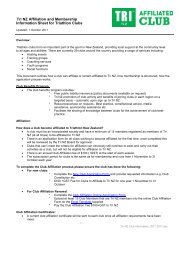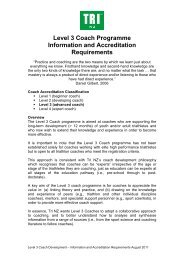2020 High Performance Plan - Triathlon New Zealand
2020 High Performance Plan - Triathlon New Zealand
2020 High Performance Plan - Triathlon New Zealand
You also want an ePaper? Increase the reach of your titles
YUMPU automatically turns print PDFs into web optimized ePapers that Google loves.
Why invest in Tri NZ?• An aligned sport with a sound and credible NSO• A robust, clear and sustainable 8-year horizon, based on Independent Review• Determination to retain our place at the very pinnacle of World <strong>Triathlon</strong>• Commitment to winning Olympic and World medals• Commitment to experienced world class staff• Athletes we believe in• Key drivers:• To get athletes and world class coaches together in world class environments• To increase the pool of NZ world class triathletes on the podium2
Fischer and the KWIA had other projects in the mix, which included twin research andthe study of the effects on the germ plasma of things such as x-rays, lead, and mercury todetermine if they caused a deterioration of the racial stock. The KWIA petitioned the RF to fundthis research, which it did. (Dr. Mengele’s twin research started at this time.) In all of thesestudies, Jews were getting “special or veiled” attention. Thus Fischer and a man by the name ofHans Günther provided Germans with the early messages about “Volk” and “Race.”In Chapter Three, the author addresses the rise of Hitler and his embracement ofanthropology. In a key 1920’s German anthropology textbook, publisher J. F. Lehmanndedicates the book to Hitler as the “primary fighter for the meaningful recognition of the racequestion” (62). The chapter traces Hitler’s rise to power and the creation of the totalitarianstate. The role of Leader Principle (Führer Princip) and the efforts to “bring everything andeveryone into line” (Gleichschaltung) with his ideas is examined. Goebbels, Streicher, andGöring stumped the anti-Semitic rhetoric that Hitler first espoused in Mein Kampf. In the effortto purify the race, eliminate the destructive elements and to create a new society headed by arevived, thriving, and growing master Aryan race, a series of laws were past over time toeventually identify and marginalize Jews in German society. By making race the center of hisideological treatise, Hitler found common ground with the German and internationalanthropological and eugenics communities. Hitler and his policies were well received andpublished in key scientific journals such as Volk und Rasse. Soon, the scientists and the statewere collaborating in the development of official policy and racial laws such as the NurembergLaws, which proved to be the defining moment in terms of the future demise of the Jews inGermany and Europe. By 1935, the KWIA had committed itself to the Nazis to draw funds fromthe government in order to continue its work.This collaboration in thinking between the KWIA and the Nazi government resulted inthe creation of some of the first German eugenics laws that focused on the use of sterilization oncriminals and social defects. With state control of health care in Germany, German doctorswillingly jumped on the Nazi bandwagon. As Germany passed through the 1930s, negativeeugenics (euthanasia) became increasingly popular and was winning state support. This wasparticularly relevant in the efforts to answer the question of what to do with the “useless eaters”and those with lives “unworthy of living.” German anthropologists referenced the widespreaduse of sterilization in the United States to validate their call for its use in Germany. With thedistraction of WW II, the T-4 campaign began and eventually the final solution to the Jewishquestion was implemented. In spite of RF reservations about the Nazi treatment of Jews, the RFcontinued to fund the racial study research of the KWIA until the start of WW II in 1939.Despite the conclusion of RF funding of twin research (the grant ran out in 1934) and concernsover the treatment of research subjects (Jews) at that time, the philanthropist, James Loeb,bequeathed $1 million to the institute to continue its research after his death in 1933.In the next chapter, Schafft addresses the discovery she made in the course of herresearch at the Smithsonian. In her efforts to ascertain what American anthropologists knewabout the work of anthropologists in Germany, she came across a collection of materials from theInstitute for German Work in the East (Institut Deutsche Ostarbeit or IDO). The cratescontaining the materials were delivered at the end of WW II (February 1947) and were nevershelved or even looked at. When the author was given permission to open the collection andcatalogue it, she jumped at the opportunity. In the crates she found hair samples, body outlines,fingerprints, crude drawings, and questionnaires detailing family history. There were also3
2005-12: Success and LearningOlympic history: London marked triathlon’s 4 th Olympic Games appearance since its debut inSydney 2000NZ’s Olympic history: 3 medals (2004 – men’s gold and silver; 2008 – men’s bronze); plus 2 x top10 women in 2008 and 20122005-2008Sport dominated by 5 countriesIn Tri NZ:• Many part-time volunteer coaches• Support services not optimised• HP training environment and standardsneeded2009-2012Sport evolving quickly:•Younger and faster•ITU series changed•Team Relay emerged•Other nations investing heavilyIn Tri NZ:•<strong>2020</strong> HP Review Commissioned and endorsed•2012 Post Olympic Review4
<strong>High</strong> <strong>Performance</strong> Programme ReviewsDecember 2011 to May 2012: Independent Review of Tri NZ HP Programme through <strong>2020</strong> lensPost London Olympic Review, supported by HPSNZKey recommendations• Establish a <strong>High</strong> <strong>Performance</strong> Director (HPD)• Centralized decision making and accountability, with robust athlete contracting and KPI’s• Adopt a narrow-base athlete pathway with higher world class standards, attitudes and behaviours• Establish training hubs to optimize coaching contact time• Tri NZ coaches lead coaching• Develop and resource talent identification and development• Utilise performance support services more effectively• Establish knowledge capture• Foster innovation5
WHERE ARE WE GOING?Section dividerpage titleplaceholder
Our Mission and Vision Through to <strong>2020</strong>MissionTo win medals consistently at the Olympic Gamesand major international eventsVisionTo provide a high performance environment thatproduces athletes who can win medals consistently atthe Olympic Games and major international events8
2016 Medal FocusTarget: 1 x Olympic MedalIndividual Women’s or Team Relay:Current strength tends towards women:•2 x top 10 @ 2012 London Olympics•2 x top 10 @ 2012 WTS Grand Finale, Auckland•3 x top 10 @ 2012 ITU U23 & U19 World Championships•Leading male 11 th @ 2012 WTS Grand Finale, and 11 th in U19 World ChampionshipsFew countries have our strength of both men and women for Team Relay:•2 men & 2 women required•One of only 3 countries with 2+2 in Olympic top 20•Only country with 2 in the top 20 of every elite race at 2012 ITU World Championships, Auckland•Opportunities to practise team format (e.g. Kinloch, CWG)•Better odds9
<strong>2020</strong> Medal FocusTarget: 2 x Olympic MedalsIndividual medal (Men or Women) and a Team Relay medalThe leadership, coaching and training environment will be entrenchedResulting in a strong all round programmeCombined strength targets a Team Relay probabilityWomen:•World U19 champion and other top 10s in the past 3 years•Plus new talent to be identified and developedMen:•Podium and top 20s at World U23 & U19 in the past 3 years•Plus new talent to be identified and developedTeam Relay:•The above will provide the basis of a world class team to challenge for an Olympic Gold in <strong>2020</strong>. The 8-year plan also gives plenty of time to develop other (perhaps yet unknown) athletes to challenge,especially over the shorter distance.10
HOW ARE WE GOING TOSection dividerGET THERE?page titleplaceholder
Four Strategic Aims1) Enhance leadership and coaching:Provide strong technical leadership around strategy development,implementation and world class coaching with increased athlete contact time.2) Establish and enforce world class performance standards:Establish an enforcement of evidence-based world class performancestandards to ensure athletes and coaches are tracking towards a podium atOlympics and World Championships.3) Optimize training environments:Create world class domestic and international training environments (HUBS)that will enable athletes and coaches to prepare optimally for pinnacleevents.4) Prioritise athlete talent development:Prioritise the structured and progressive development pathway to ensureprogramme sustainability by systematically and regularly identifying andsupporting young development athletes who show potential to podium atOlympics and World Championships.1x Medal2016 OlympicGames2 x Medals<strong>2020</strong> OlympicGames12
Strategy 1: Leadership and CoachingStrategic PathwayPodium• Athlete is coached either by Tri NZ coach ormutually agreed personal coach• Programme is signed off by Head Coach• Based periodically at international and domesticHUBs as determined by signed IPP• Focus on performancePodium Development• Tri NZ HPP coach-led programmes, withsupport from Head Coach and approvedpersonal support coaches• Individualised training and competition plan• Primarily based domestic Hub, with internationalexposure• Focus on performance developmentDevelopment• Tri NZ HPP coach-ledprogrammes in conjunction withapproved personal supportcoaches• Based between domestic Huband Home• Focus on developmentPodiumPodium DevelopmentDevelopment13
Strategy 1: Leadership and Coaching cont.Role Status <strong>Performance</strong>FocusResponsibilityDelivery<strong>High</strong> <strong>Performance</strong> Director F/T employed 2016/<strong>2020</strong> &beyondStrategic direction andleadershipHead Coach F/T employed 2016/<strong>2020</strong> Podium athlete campaigns& centralised trainingenvironment• Domestic hub• Tri NZ• HPSNZ• International as needed• Domestic hub• International base• Pinnacle eventsHPP Coach F/T employed 2016/<strong>2020</strong> Development campaigns ¢ralised trainingprogrammeTalent Development Coach F/T employed <strong>2020</strong> & beyond Development athlete (16-19 years) strategy,campaigns and engagementof pathway coaches• Domestic hub• International camps• Key events• Domestic hub• Domestic camps• Key events• Domestic Secondary schooleventsPersonal &/or specialistcoachesContract 2016 Podium athlete campaigns Invited domestic and internationalenvironmentsPathway coachesVolunteer orContract<strong>2020</strong>/2024 &beyondManage athlete entry to thesport and early developmentMainly home environments14
Strategy 2: <strong>Performance</strong> Standards• Uncompromising world class results• Stringent selection standards (talent,attitude, behaviour, results)• Aligned with international trends• Committed IPPs• Critical review and self assessment• Constructive value add support team• Clear, formal agreements• Transparent selections• Competition delivery• Pinnacle tracking• Enhancing performance support• Unambiguous processes15
Strategy 2: <strong>Performance</strong> Standards cont.Selection Standards & SupportSquad selections will be at the following 3 levels:• Podium: Tracking toward a podium finish at the 2016 Olympic Games• Podium Development: Tracking toward a top 8 finish at the 2016 Olympic Games &toward a podium finish at the <strong>2020</strong> Olympic Games• Development: Tracking toward a podium finish at the <strong>2020</strong> Olympic GamesSelected athletes will benefit from the following support:• Coaching, training environments and individual campaign plans• Athlete performance support through HPSNZ, primarily at the training hub• Financial assistance to enable training and competition at a world level through PEGs,Prime Minister’s Athlete Scholarships, Tri NZ Commercial partnerships and otheravenues• Other agreed benefits through the HPSNZ Athlete Carding programme16
Strategy 2: <strong>Performance</strong> Standards cont.Athlete development pathway (evidence-based)Years to Medal 9-10 8 7 6 5 4 3 2 1 MedalITU World ChampsJunior EliteITU WorldChamps JuniorEliteITU World U23ChampsWorld CupWTSKey<strong>Performance</strong>MenTop 16 Top 8 Top 10 (3%) Podium1 x Top8 WTS1 x WTS Podium& Top 12 atWTS finale1 x WTSPodium& Top 8 atWTS finale2 x WTSPodiums& Top 5 atOlympicTest EventITU World ChampsJunior EliteITU WorldChamps JuniorEliteITU World U23ChampsWorld CupWTSMedalKey<strong>Performance</strong>WomenTop 16 Top 8 Top 10 (3%) Podium1 x Top8 WTS1 x WTSPodium& Top 15 atWTS finale1 x WTSPodium& Top 12 atWTS finale1 x WTSPodium& Top 8 atOlympicTest EventTri NZ Squad Development Podium Development PodiumCompetitions(+ ITU WorldChamps Final)CC, Oceania Cup,AYOF, YO, MR,Single DisciplineCC, FGP,Bundesliga,Oceania Cup, MR,Single DisciplineWC, CC, FGP, Bundesliga, Oceania Cup, MR,Single DisciplineWTS, WC, FGP, Oceania Cup, MRWTS, WC,FGP,OceaniaCup, MR,CGWTS,OlympicSelectionEvent, WC,FGP,OceaniaCup, MROlympics(Individual &MR)17
Strategy 2: <strong>Performance</strong> Standards cont.Campaign <strong>Plan</strong>sTri NZ recognises that it is absolutely critical that athletes have individualised campaign plansconstructed specifically to meet their performance development needs.These plans will allow Tri NZ to:• Create specific support structures for each athlete, or groups of “like” athletes• Be effective with the use of group and/or individual training/coaching, to fit the needs of the athletes• Recruit specialised coaching and support services• Create accountability to the coach and athlete<strong>Plan</strong>s, processes and performances will be tracked constantly and formally reviewed 6-monthly byathletes, coaches, national coaches and HPD, to assess effectiveness in closing the gaps to thepodium.Athletes and programmes can therefore not be supported by Tri NZ without an agreed and adhered tocampaign plan (including IPP).A campaign plan will be included for Team Relays to optimize championships medal chances.18
Strategy 2: <strong>Performance</strong> Standards cont.ExpectationsAn Agreement will be developed collaboratively, detailing the attitude andbehaviours expected of all members of the Tri NZ HP Team (athletes, coaches andsupport staff).It will reflect that Team members must:• Fully commit to the goals of the Tri NZ HP Programme• Embrace a culture of excellence – working together with support and challenge toachieve individual and collective goals• Collaborate on and commit to robust and effective IPPs• Behave with respect for themselves, their teammates and Tri NZ at all times• Honour commitments to Tri NZ, Tri NZ commercial partners, HPSNZ and the NZOC• Fully commit to drug free sport and the education and compliance requirements ofDrug Free Sport <strong>New</strong> <strong>Zealand</strong> and WADA19
Strategy 3: Training EnvironmentsCentralised Training Hub• More contact time between coaches and athletes• Increased collaboration among coaching team• More effective integration of performance services• <strong>High</strong> quality training groups• Access to optimal physical training environments• Stronger relationships, reflecting the importance of Teamsracing• Greater accountability• Short list: Cambridge, Christchurch, Nelson• Decision c. January 2013• Roll out implementation c. April 201320
Strategy 3: Training Environments cont.Athlete <strong>Performance</strong> Support<strong>Performance</strong> services must enhance!Most effective/efficient when embedded• Lead scientist: Analyse, track, challengeand innovate• Mental skills: Engender performancelifestyle, attitude and skills• Musculoskeletal: Develop, maintain andrecover optimum physical state• Medical, nutrition and movementspecialists21
Strategy 4: Talent DevelopmentPrior to HP Programme SelectionTalent Development Leadership•Full-time coach focused on finding and supporting new talent•Initiatives throughout the country•Familiar with genuine international standards•Hands-on coaching and supporting local coaches•Coaching within the U19 squad and will develop coaches of key athletes.PodiumPodiumDevelopmentDevelopmentHP SquadsAthletes aged 16-19: Key strategies•Establish selection and confirmation criteria•Increase contact time between development coach and keyathletes and personal coaches (e.g., camps)•Establish national databases (potential talent transfer)•Establish partners; schools, clubs, regional squads, feeder sports•Strong relationship with parents•Tri NZ owned Sec Schools event series16-19 yearsAthletes aged < 16: Key strategies•Establish national databases (talent transfer)•Support local intro coaches•Strong relationship with parents•Tri NZ owned Sec Schools event series< 16 years22
Section dividerTo get athletes and world class coachestogether in world class environmentspage titleplaceholderTo increase the pool of NZ world classtriathletes on the podiumTo win medals consistently at the OlympicGames and major international events



